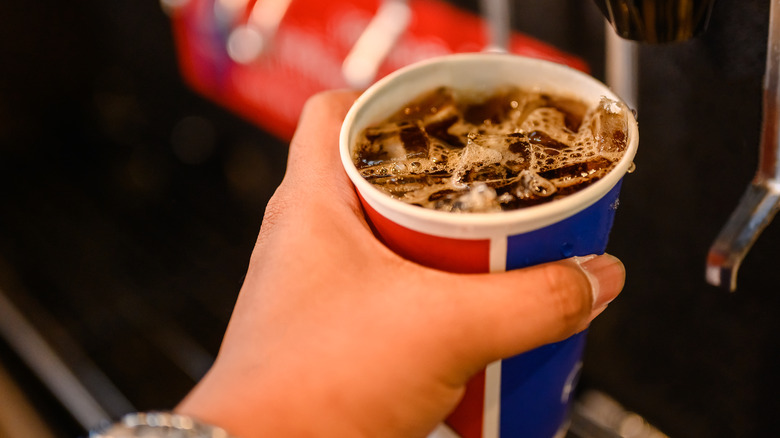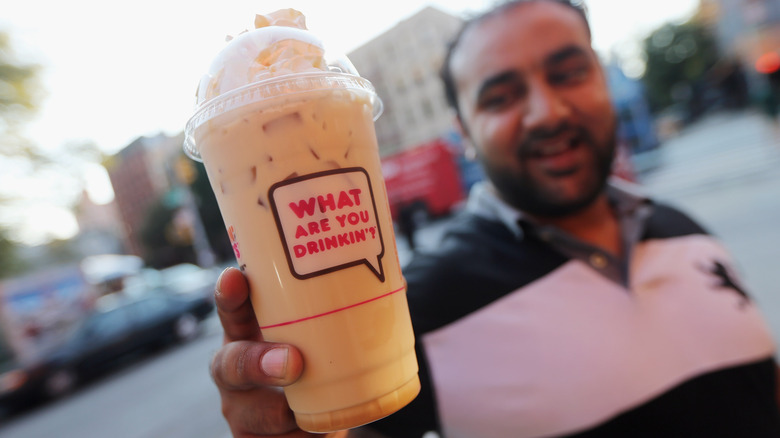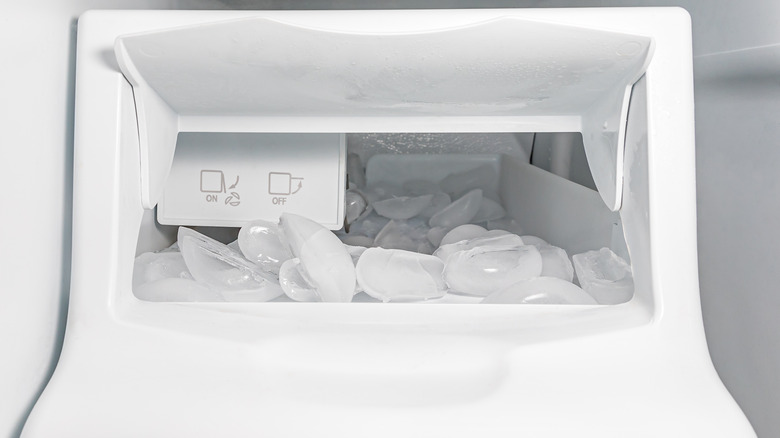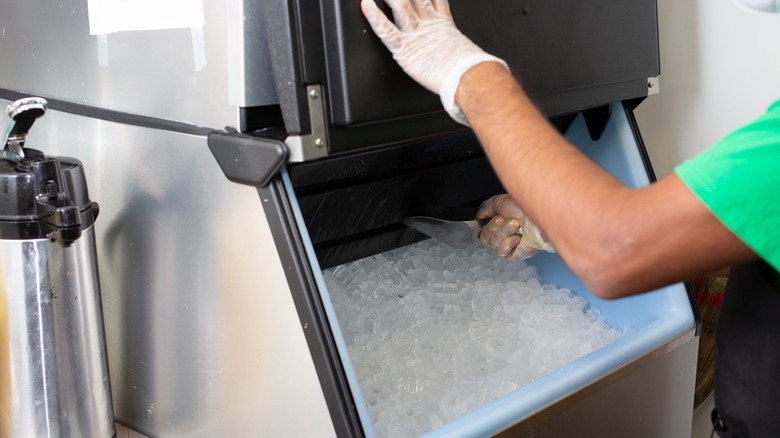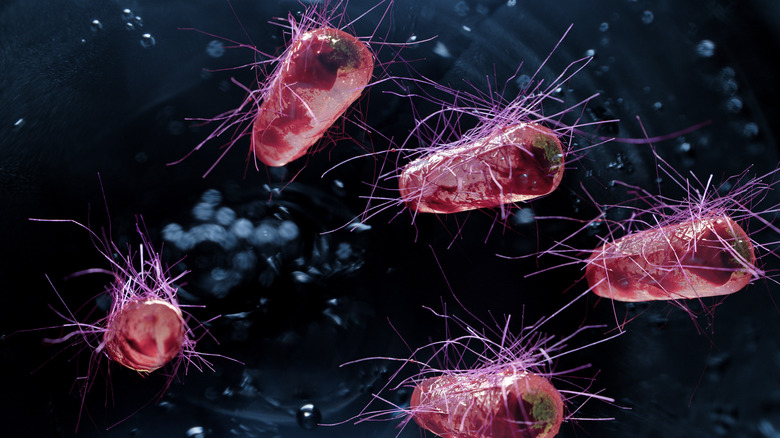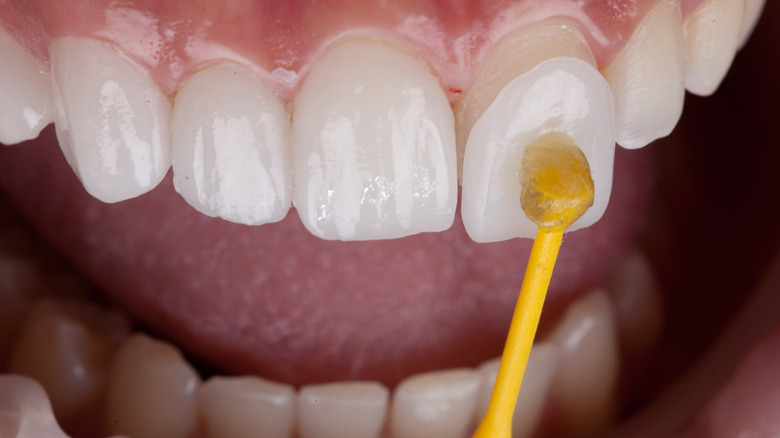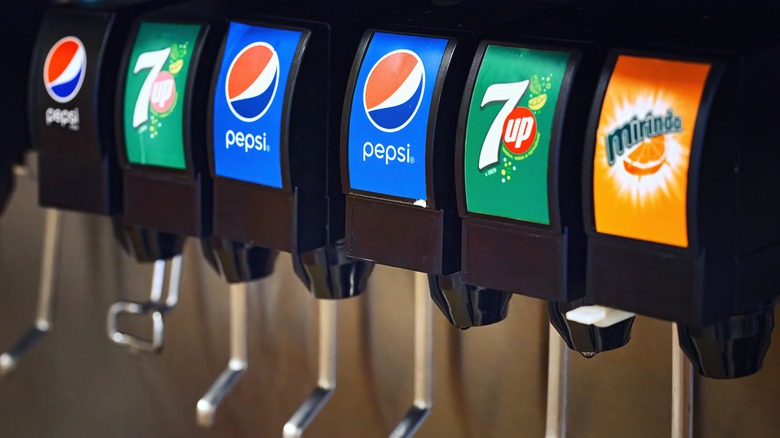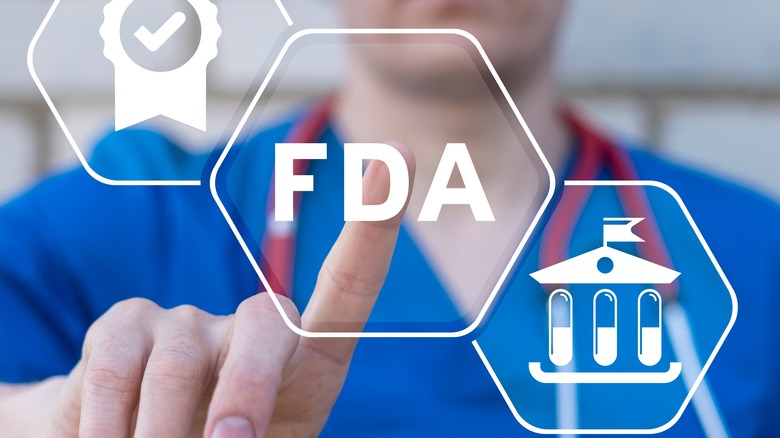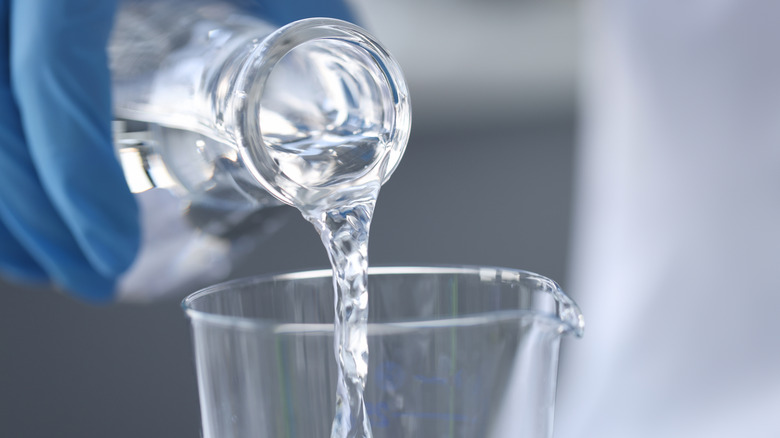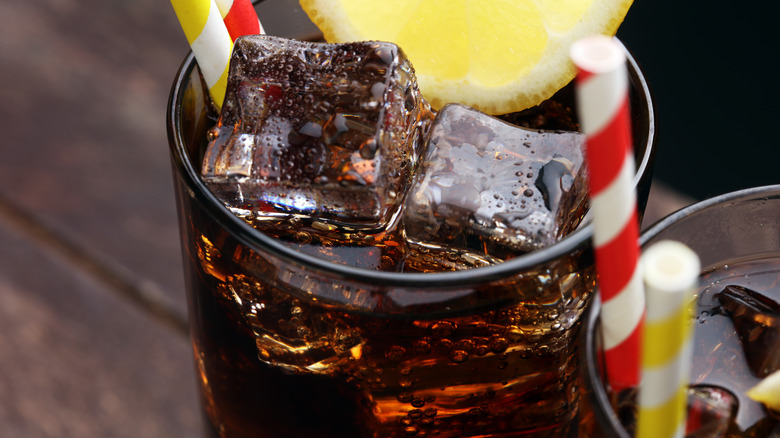Why You Should Avoid Fast Food Ice At All Costs
The words "ice cold" conjures up ideas of satisfying refreshment on hot summer days — and there's nothing quite like a cold, frosty fountain drink to quench the thirst. An icy soda is the perfect way to wash down fast-food burgers, fries, and burritos. But is there a cost hidden behind that delicious treat?
You may have heard that fast food ice is not that healthy or hygienic, but is that true? What's the story behind this frozen H20? The truth is, you should probably avoid fast food ice at all costs. Besides some particular health concerns, culinarily and economically, it is not a great choice.
Unfortunately, you might want to stick to making ice at home — an excellent investment, considering there are many cool ice cube hacks out there. However, if you do choose to continue eating fast food ice, at least you will be aware of the potential risks. Here's why we think you should not consume fast food ice.
It's a waste of money
Ice cubes take up a lot of volume in a cup. In fact, back in 2021, TikTok user @jasonmora2 revealed in a video just how little liquid you get due to the amount of ice in drinks at Dunkin' Donuts. The amount of coffee in a large iced coffee filled up less than half of the drink cup once the liquid was poured from the ice.
That's just money down the drain. To get an idea of just how much ice fast food companies use, Prima Supply, a restaurant equipment supply company, estimates that fast food retailers should count on needing just under a pound of ice per customer daily.
The good news is that you can always ask for less ice — or no ice at all. And fast food chains will likely honor your request free of charge. While there was a rumor circulating in April 2023 regarding Starbucks' ice policy and that the coffee chain would begin up-charging for no ice, Starbucks quickly shut it down. That said, it is true that not putting ice in your drink results in more company expenditure, which may eventually trickle down to the customer.
It might be really dirty
Another compelling reason to avoid fast food ice at all costs is that it might be filthy. Some studies have found toilet water and ice cubes to contain the same bacteria, such as E.coli. Back in 2006, a middle school student shocked the world when her science experiment revealed that a whopping 70% of the time, ice cubes contained more bacteria than toilet water.
"These [bacteria] don't belong there," Dr. David Katz, medical contributor to Good Morning America, told ABC News. "It's not cause for panic, although it is alarming because what she found is nothing new. You're not more likely to get sick now. But she's done us a favor by sounding the alarm." Over a decade later, a 2017 investigation done by BBC found that these conditions had not changed.
The UK's Food Standards Agency spokesperson stated, "The findings suggest that either poor quality water has been used to make the ice, or that contamination has occurred because of poor hygiene practices (such as staff failing to wash their hands before handling the water/ice)." All of this information means that there are many ways fast food ice can get dirty — all the more reason to avoid it.
The machine might not be cleaned properly
One of the reasons that fast food ice can get dirty is if the machines are not properly cleaned. QSR Magazine explains that ice machines must be inspected and cleaned preemptively before "pink, green, brown, or black mold" can grow. Each device has its own procedure, but generally, a machine should be inspected at least weekly, and any cleaning done should be double-checked, especially internal parts.
The process of cleaning an ice machine is no simple task, but regardless, people should follow best practices to avoid contamination. These include watching their hands before handling ice, using a clean, sanitized scooper, and only touching the handle. The cleaning process typically involves removing all the ice from the device, putting the machine in wash mode, adding cleaner, removing the internal components, and then washing those separately.
Finally, everything needs a final rinse before the machine is ready to make ice again. With such specific requirements, it's no wonder that not all fast food ice machines are always sparkling clean.
It can make you really sick
While it's true that there are not many recorded instances of people getting very sick from ice machines, that does not mean it is impossible. In 2016, two fatal cases of Legionnaires' disease, a form of pneumonia, were traced back to a hospital ice machine (via The Seattle Times). Hygiene Food Safety says that consuming dirty ice can lead to cholera, salmonella, E.coli, norovirus, and more. The outlet warns that cold temperatures cannot kill bacteria as many people think.
What happens if you get E.coli? The NHS says if you become symptomatic, you can expect diarrhea (sometimes bloody), stomach cramps, and fever. The symptoms usually start three to four days after infection and can last about two weeks. The good news is that most people recover from E.coli infection at home, without medical intervention. In rare cases, you can develop haemolytic uraemic syndrome (HUS), which can be fatal. Those most commonly affected by HUS are kids under five.
Ice could damage your teeth
Even if your ice is not contaminated, it can still be hazardous to your health. Specifically, it can damage your teeth. The American Dental Association (ADA) categorizes ice as "one of the top nine foods that damage your teeth" (via WebMD). "Tooth enamel is a crystal. Ice is a crystal. When you push two crystals against each other, one will break," Dr. Matthew Messina told MouthHealthy.
While the tooth usually wins in the battle between ice and tooth, that's not always the case. Sometimes ice will crack your teeth or wear down the enamel, which makes you more prone to cavities. Ice can also cause gum irritation and recession. Further, if you wear braces or have fillings, chewing ice can damage them. So, if you find yourself chewing on the ice in your fast food drink, cut out the temptation and ask for no ice.
As a side note, if you do find yourself chewing ice constantly, consider whether this is a craving. Pagophagia, a form of pica, is the "intense craving to chew on ice," as described by WebMD. Often, it can be a sign of an underlying health condition. Sometimes people with anemia or iron deficiency develop pagophagia. It can also result from calcium deficiency, dry mouth, and mental health conditions. Besides dental problems, pagophagia can lead to malnutrition, fatigue, dizziness, and depression, among other symptoms. If you suspect you might have pagophagia, it's best to talk to your healthcare professional.
It makes your drink taste weird
It's a common scenario: It's a hot day, and you're eating your burger and chatting with some friends. Soon enough, the ice in your drink starts to melt. That soda you paid precious money for no longer tastes quite the same. When ice melts, it dilutes your drink.
The type of ice you use in your drink matters. Expert mixologist Ana Gracia tells Insider that larger ice cubes last longer before they start to melt, maintaining the integrity of your drink for longer. Think about the ice you get from your local fast-food joint. Most of it is smaller and translucent, meaning it will melt sooner rather than later.
Further, ice shouldn't be cloudy. Wirecutter explains that because cloudy ice has "air pockets," it flattens out soda more quickly than clear ice does. When soda hits the air pockets, it causes more instant fizzing and immediate death to carbonation. So, if you're at a fast-food joint in person, check the clarity of the ice cubes before adding them to your drink.
The FDA doesn't regulate it
Ice is considered a food, which means the U.S. Food and Drug Administration (FDA) regulates it. However, it only regulates packaged ice. As such, the ice that fast food restaurants make is not being regulated. According to the FDA, "... ice manufacturers must produce, hold, and transport ice in clean and sanitary conditions, monitor the cleanliness and hygiene of employees, use properly cleaned and maintained equipment, and use water that is safe and sanitary."
It's important to remember that while the FDA does not regulate fast food ice, state and local agencies do regulate fast food establishments. If you're ever unsure about whether you're in a dirty restaurant, you can check its health department rating. Depending on your jurisdiction, this rating might be on display in a window of the establishment or available online. If you are unsure of the restaurant's rating and do not want to avoid the location, perhaps skip on the ice.
Fast food ice could contain additives
As previously mentioned, one of the reasons ice can be contaminated is because of the water used. But contamination is not the only issue to consider when thinking about the water from which ice is made. If the fast food restaurant does not use filtered water to make its ice, there may be added chemicals and heavy metals inside the ice that may or may not be harmful.
According to water-treatment company EcoWater Systems, chloramine (a combination of chlorine and ammonia) used to treat water can end up in ice if not adequately filtered. The CDC says that while water companies monitor these levels for safety, some people are more "sensitive" to the chlorine and chloramine used to treat water.
And while it may not be hazardous to your health, it can affect the taste, which could be positive or negative, depending on your preference. To note: Chlorinated water harms your aquatic and reptilian housemates. Don't give them any ice or water about which you are unsure.
Not all ice is created equal
Leaving health and gustatory concerns aside, ice cube shape matters — and not all fast food shops rank equally in the ice cube department. Fast food ice comes in different shapes (and colors). It all depends on what you value. If you like small "nugget" ice cubes, you might go to Sonic.
However, if you are looking for your drink to contain as much liquid as you actually purchased instead of a cup full of ice, a place like Dunkin' Donuts might be one to avoid (despite its clear, large ice cubes). Or, opting out of ice altogether may be your best bet — but keep in mind, some fast food restaurant apps (like the beloved Taco Bell) do not let customers select "no ice" on beverages.
With such variation, it may be best to just avoid fast food ice unless you are sure you know what you will get. Unfamiliar or unsatisfying ice could ruin the whole soft drink experience. And with inflation causing soda prices to soar, it is just not worth it. Unfortunately, fast-food ice is a tricky subject, and it may be time to start making your own high-quality ice at home.
